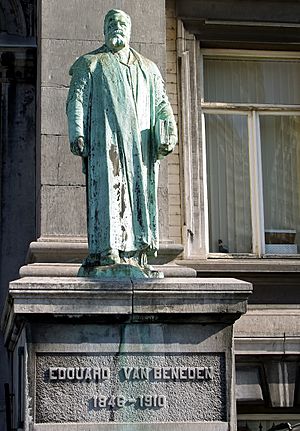Edouard van Beneden facts for kids
Edouard Joseph Marie Van Beneden (born in Leuven on March 5, 1846, and passed away in Liège on April 28, 1910) was a famous scientist. He studied cells (a cytologist) and sea life (a marine biologist). He was a professor of zoology, which is the study of animals, at the University of Liège. He made important discoveries in how cells work and how living things pass on traits.
Contents
Discovering How Cells Divide
Edouard Van Beneden did a lot of his important work by studying a type of roundworm called Ascaris. He looked closely at how the tiny parts inside cells, called chromosomes, behaved.
Chromosomes and Reproduction
Van Beneden discovered how chromosomes combine when new cells are made for reproduction. This process is called meiosis. During meiosis, special cells called gametes (like sperm and egg cells) are formed. He showed that these gametes only get half the usual number of chromosomes. This is a very important step for how living things inherit traits from their parents.
Mitosis: Cell Copying
Along with other scientists like Walther Flemming and Eduard Strasburger, Van Beneden also helped us understand another way cells divide, called mitosis. In mitosis, a cell makes an exact copy of itself. The new cells, called daughter cells, have the same number of chromosomes as the original parent cell. This means they have a full, double set of chromosomes, which scientists call diploid. Mitosis is how our bodies grow and repair themselves.
Meiosis: Making New Life
Meiosis is different from mitosis. It's all about making gametes for reproduction. In meiosis, a cell divides in a way that each new gamete ends up with only one set of chromosomes. This is called being haploid. When a sperm and an egg (both haploid) combine, they form a new cell with a full, diploid set of chromosomes, starting a new organism.
His Father's Legacy
Edouard Van Beneden's father, Pierre-Joseph van Beneden (1809–1894), was also a well-known biologist. He introduced two important ideas in the study of how living things interact with each other and their environment. These ideas are mutualism and commensalism. Mutualism is when two different species help each other, and commensalism is when one species benefits without harming or helping the other.
See also
 In Spanish: Édouard van Beneden para niños
In Spanish: Édouard van Beneden para niños


